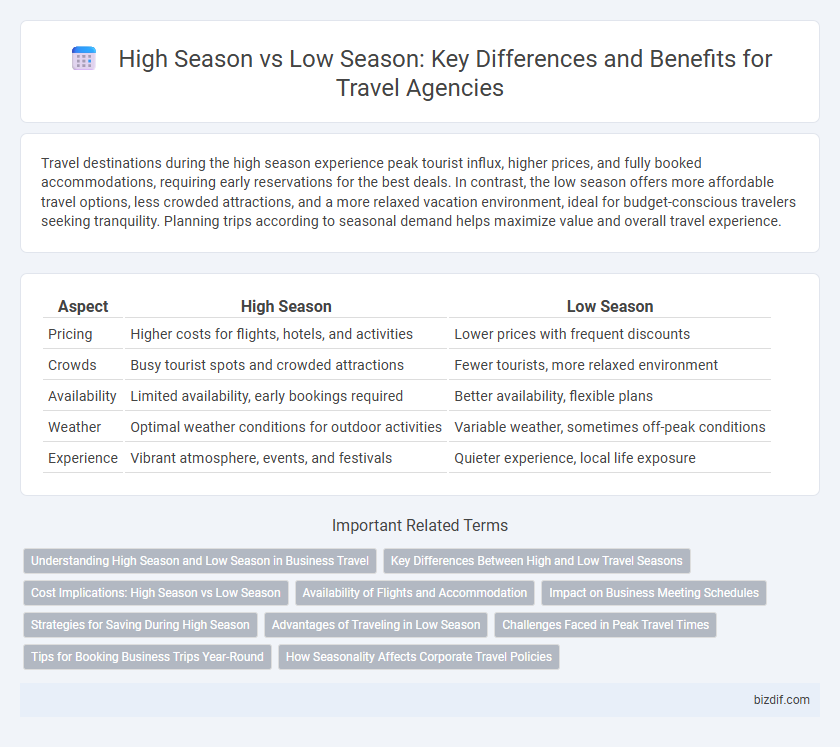Travel destinations during the high season experience peak tourist influx, higher prices, and fully booked accommodations, requiring early reservations for the best deals. In contrast, the low season offers more affordable travel options, less crowded attractions, and a more relaxed vacation environment, ideal for budget-conscious travelers seeking tranquility. Planning trips according to seasonal demand helps maximize value and overall travel experience.
Table of Comparison
| Aspect | High Season | Low Season |
|---|---|---|
| Pricing | Higher costs for flights, hotels, and activities | Lower prices with frequent discounts |
| Crowds | Busy tourist spots and crowded attractions | Fewer tourists, more relaxed environment |
| Availability | Limited availability, early bookings required | Better availability, flexible plans |
| Weather | Optimal weather conditions for outdoor activities | Variable weather, sometimes off-peak conditions |
| Experience | Vibrant atmosphere, events, and festivals | Quieter experience, local life exposure |
Understanding High Season and Low Season in Business Travel
High season in business travel typically coincides with peak conference periods, major trade shows, and industry events when demand for flights, accommodations, and transport services surges, driving up prices and availability constraints. Low season occurs during off-peak months when fewer corporate events take place, leading to reduced travel costs, greater flexibility in booking, and enhanced service options from airlines and hotels. Strategic planning around these seasonal fluctuations can optimize travel budgets and improve itinerary efficiency for corporate travelers.
Key Differences Between High and Low Travel Seasons
High travel seasons typically feature peak demand, higher prices, and crowded destinations due to favorable weather and holidays, making it ideal for popular attractions and events. Low travel seasons offer reduced costs, fewer tourists, and a more relaxed experience, often with unpredictable weather and limited services. Understanding these key differences helps travelers balance budget, comfort, and activities when planning trips.
Cost Implications: High Season vs Low Season
Travel costs during the high season typically surge due to increased demand for flights, accommodations, and popular tourist activities, resulting in premium pricing. In contrast, the low season offers significant savings with discounted rates on hotels, airfare, and tours, appealing to budget-conscious travelers. Understanding these cost implications helps travelers strategically plan trips to optimize expenses while enjoying desired destinations.
Availability of Flights and Accommodation
Flight and accommodation availability significantly varies between high and low travel seasons, with high season experiencing limited options and higher prices due to increased demand. During low season, travelers benefit from more abundant flight schedules and a wider selection of accommodations, often at discounted rates. Booking during low season enhances flexibility and access to premium lodging, while high season requires early reservations to secure preferred flights and stays.
Impact on Business Meeting Schedules
High season in the travel industry typically sees increased demand and higher travel costs, influencing business meeting schedules due to limited availability of venues and accommodations. During low season, companies benefit from more flexible booking options, reduced prices, and less competition for prime meeting times, facilitating easier planning. Understanding these seasonal impacts enables travel agencies to optimize their clients' business meetings for cost-efficiency and convenience.
Strategies for Saving During High Season
Travel agencies recommend booking flights and accommodations well in advance during the high season to secure better rates and availability. Utilizing flexible travel dates and exploring less popular destinations within peak periods can significantly reduce costs. Leveraging loyalty programs and last-minute deals also provides strategic savings even during peak travel times.
Advantages of Traveling in Low Season
Traveling during the low season offers significant advantages such as lower prices on flights, accommodations, and tours, allowing budget-conscious travelers to explore destinations more affordably. Less crowded attractions and popular sites provide a more authentic and relaxed experience without long wait times or overcrowding. Additionally, travelers can enjoy personalized service from hospitality providers who tend to have more availability and flexibility during off-peak months.
Challenges Faced in Peak Travel Times
Peak travel times strain travel agencies with heightened demand for accommodations, flights, and tours, often leading to limited availability and increased pricing. Managing customer expectations becomes crucial as delays and service disruptions rise during high season due to overcrowded destinations and transportation networks. Agencies must optimize resource allocation and employ dynamic pricing strategies to maintain profitability and customer satisfaction amid these operational challenges.
Tips for Booking Business Trips Year-Round
Booking business trips during high season requires early reservations to secure preferred accommodations and optimize travel schedules. Low season travel allows for greater flexibility and cost savings, ideal for non-urgent meetings or conferences. Utilizing dynamic pricing tools and monitoring airline trends can further enhance budget efficiency throughout the year.
How Seasonality Affects Corporate Travel Policies
Corporate travel policies often tighten during high season due to increased costs and limited availability, prompting companies to enforce stricter budgeting and advance booking requirements. During low season, organizations typically enjoy greater flexibility and cost savings, enabling more frequent or extended business trips with relaxed spending limits. Understanding these seasonal fluctuations helps travel managers optimize travel schedules, negotiate better rates, and improve overall travel efficiency.
High season vs Low season Infographic

 bizdif.com
bizdif.com